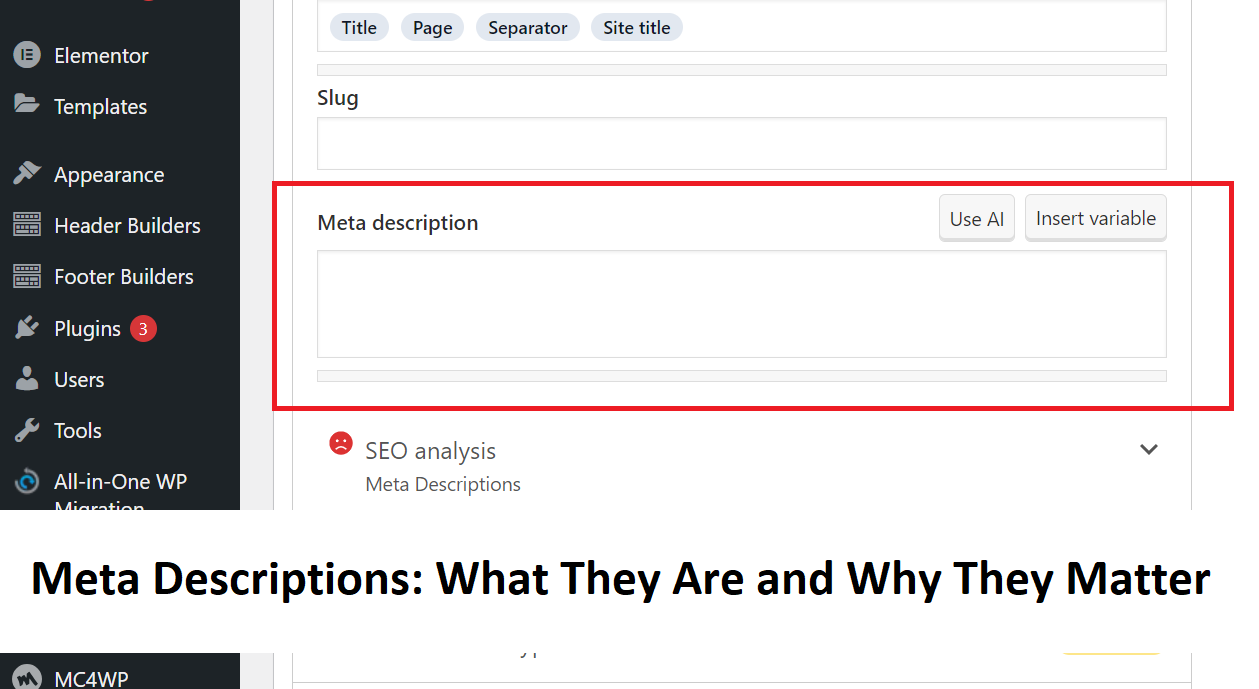
Meta descriptions are a crucial aspect of search engine optimization (SEO) that often go overlooked. A meta description is a brief summary of the content on a webpage that appears in search engine results pages (SERP). It is an opportunity for website owners to entice users to click through to their website by providing a concise and compelling description of what the page offers.
A well-written meta description can have a significant impact on a website’s click-through rate (CTR) and ultimately, its search engine ranking. However, many website owners neglect to write unique and informative meta descriptions, instead relying on automated descriptions generated by search engines. This can result in generic, unhelpful descriptions that do not accurately represent the content on the page. In this article, we will explore the importance of meta descriptions and provide tips for writing effective ones that can help improve a website’s visibility and click-through rate.
Understanding Meta Descriptions
Purpose and Importance
Meta descriptions are HTML elements that provide a brief summary of a webpage. They appear below the page’s URL and title in search engine results pages (SERPs). The purpose of a meta description is to give users a snapshot of what the page is about and entice them to click through to the website.
Meta descriptions are important for several reasons. First, they reflect search intent and align with what the person searching is actually looking for. Second, they can improve click-through rates (CTR) and increase organic traffic to a website. Third, they can impact a website’s search engine ranking. While meta descriptions are not a direct ranking factor, they can indirectly influence ranking by improving CTR and reducing bounce rates.
Character Length Best Practices
The character length of a meta description is an important consideration. While there is no set limit, Google typically displays up to 155-160 characters in search results. It is recommended to keep meta descriptions within this limit to ensure they are fully displayed in search results.
In addition to character length, there are a few best practices to follow when writing meta descriptions. First, they should accurately reflect the content of the page. Misleading or inaccurate meta descriptions can lead to high bounce rates and negatively impact a website’s search engine ranking. Second, they should include relevant keywords to improve visibility in search results. However, it is important to avoid keyword stuffing and ensure the meta description reads naturally. Finally, they should include a call-to-action (CTA) to entice users to click through to the website.
Overall, meta descriptions are an important aspect of on-page optimization and can have a significant impact on a website’s search engine ranking and organic traffic. By following best practices for character length and content, website owners can improve the visibility and click-through rates of their pages in search results.
Creating Effective Meta Descriptions
Meta descriptions play a crucial role in attracting visitors to your website. A well-written meta description can increase the click-through rate to your website, which can indirectly impact your SEO rankings. Here are some tips to help you create effective meta descriptions.
Writing Compelling Content
Your meta description should be interesting enough to grab readers’ attention while accurately summarizing the page content. It should provide a clear idea of what the page is about and why it is relevant to the reader’s search query.
To write compelling content, consider the following:
- Keep it concise: Meta descriptions should be no more than 155 characters. Avoid fluff and filler words, and focus on the most important information.
- Use active voice: Active voice is more engaging and helps convey a sense of action and urgency.
- Highlight unique selling points: What sets your page apart from others? Highlighting unique selling points can help attract visitors.
- Use emotional triggers: Emotions can be a powerful motivator. Consider using emotional triggers such as curiosity, fear, or excitement to encourage clicks.
Incorporating Target Keywords
Including target keywords in your meta description can help improve its relevance to the reader’s search query. However, avoid keyword stuffing, which can negatively impact your SEO rankings.
To incorporate target keywords effectively, consider the following:
- Use relevant keywords: Choose keywords that accurately reflect the page content and are relevant to the reader’s search query.
- Use variations: Use variations of your target keywords to avoid repetition and make your meta description more natural-sounding.
- Don’t overdo it: Avoid cramming too many keywords into your meta description. Aim for a natural-sounding, informative description that accurately reflects the page content.
By following these tips, you can create effective meta descriptions that attract visitors to your website and improve your SEO rankings.
SEO Best Practices for Meta Descriptions
Meta descriptions are an important aspect of on-page SEO. They provide a brief summary of the page’s content and help search engines understand what the page is about. Here are some best practices to follow when creating meta descriptions:
Avoiding Duplication
Duplicate meta descriptions can confuse search engines and cause them to ignore your pages. It’s important to create unique meta descriptions for each page on your site. This can be time-consuming, but it’s worth the effort.
To avoid duplication, consider using dynamic variables in your meta descriptions. For example, you can include the page title or category in the meta description. This will help make each meta description unique and relevant to the page content.
Ensuring Relevance to Page Content
Meta descriptions should accurately reflect the content of the page. This helps users understand what they can expect to find on the page and can help improve click-through rates.
To ensure relevance, include the primary keyword for the page in the meta description. This will help search engines understand the topic of the page and can improve its visibility in search results. However, avoid keyword stuffing and ensure that the meta description reads naturally and provides value to the user.
In summary, creating unique and relevant meta descriptions is an important aspect of on-page SEO. By following these best practices, you can improve the visibility of your pages in search results and provide a better user experience for your audience.
Meta Descriptions and User Experience
Meta descriptions play a crucial role in search engine optimization (SEO) and user experience. A well-written meta description can entice users to click through to a website and provide them with a clear idea of what they can expect to find on the page.
Impact on Click-Through Rates
One of the primary benefits of an effective meta description is that it can significantly impact click-through rates (CTR) from search engine results pages (SERPs). A meta description that accurately reflects the content of a page and includes relevant keywords can entice users to click through to the website. In contrast, a poorly written or irrelevant meta description can discourage users from clicking through, even if the page is otherwise relevant to their search query.
Influence on User Engagement
In addition to impacting CTR, a well-crafted meta description can also influence user engagement with a website. By providing users with a clear idea of what they can expect to find on a page, a meta description can help ensure that users who click through to the website are more likely to engage with the content. This can include spending more time on the page, exploring additional content on the website, or taking other desired actions, such as making a purchase or filling out a contact form.
Overall, meta descriptions are an essential component of effective SEO and user experience. By crafting clear, concise, and relevant meta descriptions, website owners can help ensure that their pages are more visible in SERPs and more engaging to users who click through to their website.
Tools and Techniques for Meta Descriptions
Utilizing SEO Tools
There are several SEO tools available that can help create and optimize meta descriptions. These tools can help identify relevant keywords, analyze competitors’ meta descriptions, and provide suggestions for improvement. Some popular SEO tools for meta descriptions include:
- Moz
- SEMrush
- Yoast SEO
Moz provides a comprehensive guide to writing effective meta descriptions and offers a free tool for analyzing and optimizing meta descriptions. SEMrush offers a similar tool that can analyze meta descriptions and provide suggestions for improvement. Yoast SEO is a popular WordPress plugin that can help optimize meta descriptions for individual pages and posts.
Analyzing Performance Metrics
In addition to utilizing SEO tools, it is important to analyze performance metrics to determine the effectiveness of meta descriptions. This can include monitoring click-through rates (CTR) and conversion rates for individual pages. Google Analytics is a popular tool for tracking these metrics and can provide insights into which meta descriptions are driving the most traffic and conversions.
It is important to regularly review and update meta descriptions based on performance metrics and changes to search engine algorithms. By utilizing SEO tools and analyzing performance metrics, businesses can create effective meta descriptions that drive traffic and conversions to their website.
Frequently Asked Questions
How long should a meta description be for optimal SEO?
There is no perfect length for a meta description, but generally, a length of 155 characters or 920 pixels is considered optimal. However, a minimum length of 70 characters or 430 pixels is also valid for most devices for Google. The length of a meta description will depend on the content of the page and the keywords that are being targeted.
What are some best practices for writing meta descriptions?
When writing a meta description, it is important to include relevant keywords that accurately reflect the content of the page. The meta description should also be written in a way that is compelling and encourages users to click through to the page. Avoid using clickbait or making exaggerated claims in the meta description, as this can lead to a negative user experience.
How does a meta description impact search engine rankings?
While a meta description does not directly impact search engine rankings, it can indirectly affect rankings by influencing click-through rates. If a meta description is well-written and accurately reflects the content of the page, it can encourage users to click through to the page, which can improve engagement metrics such as bounce rate and time on site. These metrics can, in turn, indirectly impact search engine rankings.
Can meta descriptions affect click-through rates from search engine results pages?
Yes, a well-written meta description can have a significant impact on click-through rates from search engine results pages. A meta description that accurately reflects the content of the page and is written compellingly can encourage users to click through to the page. On the other hand, a poorly written meta description that does not accurately reflect the content of the page can discourage users from clicking through, which can result in lower click-through rates.
What tools can be used to check the effectiveness of a meta description?
Several tools can be used to check the effectiveness of a meta description, including Google Search Console, Moz, and SEMrush. These tools can provide insights into how often a page is appearing in search results, how many clicks it is receiving, and how well the meta description is performing.
How do you write a meta description that accurately reflects page content?
When writing a meta description, it is important to accurately reflect the content of the page. This can be done by including relevant keywords and providing a concise summary of the page’s content. The meta description should also be written in a way that is compelling and encourages users to click through to the page. It is important to avoid using clickbait or making exaggerated claims in the meta description, as this can lead to a negative user experience.




